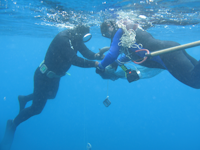Adventure tourism
Scuba Diving

In Chile you can become absorbed by the depth of the Ocean. With thousands of miles of coast, scuba diving is an activity that adds more and more people to its member’s list, people who want to go into a completely different world, one that is just amazing.
Chile’s coast is populated with quite a varied flora and fauna, you can get to see seaweed and fish of extraordinary colors swimming around saying hello to those who are adventurous enough to discover the secrets hidden under the water.
Although you can practice scuba diving all along the country, the most visited places are northern Chile going south until you reach La Serena, because there the water’s temperature is quite mild. The same happens in Easter Island, where several places have been defined to go under water. In southern Chile, however, you can still go scuba diving –in the summer-, although you should know that the water is a lot colder and submersion is subject to change according to climate conditions. You can go scuba diving in Juan Fernandez Archipelago as well.
The mysteries hidden under the ocean can be revealed with the help of an instructor, who is the one in charge of guiding you when it comes to the places you can dive in and everything you need to know about the sport itself.
To scuba dive in Chile you need to be in good physical shape and, above all, psychological shape. You should also have a certification if you are going to practice diving with compressed air, certification that can be obtained at the Dirección General del Territorio Marítimo, where you take a written test and a practical one.
The equipment to practice this sport includes a pair of flippers, hydrostatic vest, mask, isothermal suit, manometer, regulator, gloves, knife, boots, lantern, snorkel and watch, amongst other utensils.
When it comes to recommendations about this sport, the main one is to be over twelve years of age. Then, it is asked that you respect and protect the sea, especially the bottom of the ocean because it is easily destroyed by human touch. So don’t take out any shells or starfish you see, always dive with someone else, test the equipment before you jump into the water and plan your excursions in both time and distance.